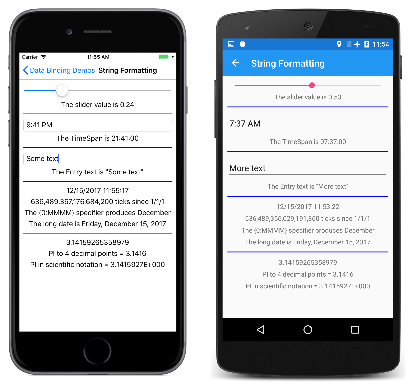Not
Åtkomst till den här sidan kräver auktorisering. Du kan prova att logga in eller ändra kataloger.
Åtkomst till den här sidan kräver auktorisering. Du kan prova att ändra kataloger.
Sometimes it's convenient to use data bindings to display the string representation of an object or value. For example, you might want to use a Label to display the current value of a Slider. In this data binding, the Slider is the source, and the target is the Text property of the Label.
When displaying strings in code, the most powerful tool is the static String.Format method. The formatting string includes formatting codes specific to various types of objects, and you can include other text along with the values being formatted. See the Formatting Types in .NET article for more information on string formatting.
The StringFormat Property
This facility is carried over into data bindings: You set the StringFormat property of Binding (or the StringFormat property of the Binding markup extension) to a standard .NET formatting string with one placeholder:
<Slider x:Name="slider" />
<Label Text="{Binding Source={x:Reference slider},
Path=Value,
StringFormat='The slider value is {0:F2}'}" />
Notice that the formatting string is delimited by single-quote (apostrophe) characters to help the XAML parser avoid treating the curly braces as another XAML markup extension. Otherwise, that string without the single-quote character is the same string you'd use to display a floating-point value in a call to String.Format. A formatting specification of F2 causes the value to be displayed with two decimal places.
The StringFormat property only makes sense when the target property is of type string, and the binding mode is OneWay or TwoWay. For two-way bindings, the StringFormat is only applicable for values passing from the source to the target.
As you'll see in the next article on the Binding Path, data bindings can become quite complex and convoluted. When debugging these data bindings, you can add a Label into the XAML file with a StringFormat to display some intermediate results. Even if you use it only to display an object's type, that can be helpful.
The String Formatting page illustrates several uses of the StringFormat property:
<ContentPage xmlns="http://xamarin.com/schemas/2014/forms"
xmlns:x="http://schemas.microsoft.com/winfx/2009/xaml"
xmlns:sys="clr-namespace:System;assembly=netstandard"
x:Class="DataBindingDemos.StringFormattingPage"
Title="String Formatting">
<ContentPage.Resources>
<ResourceDictionary>
<Style TargetType="Label">
<Setter Property="HorizontalTextAlignment" Value="Center" />
</Style>
<Style TargetType="BoxView">
<Setter Property="Color" Value="Blue" />
<Setter Property="HeightRequest" Value="2" />
<Setter Property="Margin" Value="0, 5" />
</Style>
</ResourceDictionary>
</ContentPage.Resources>
<StackLayout Margin="10">
<Slider x:Name="slider" />
<Label Text="{Binding Source={x:Reference slider},
Path=Value,
StringFormat='The slider value is {0:F2}'}" />
<BoxView />
<TimePicker x:Name="timePicker" />
<Label Text="{Binding Source={x:Reference timePicker},
Path=Time,
StringFormat='The TimeSpan is {0:c}'}" />
<BoxView />
<Entry x:Name="entry" />
<Label Text="{Binding Source={x:Reference entry},
Path=Text,
StringFormat='The Entry text is "{0}"'}" />
<BoxView />
<StackLayout BindingContext="{x:Static sys:DateTime.Now}">
<Label Text="{Binding}" />
<Label Text="{Binding Path=Ticks,
StringFormat='{0:N0} ticks since 1/1/1'}" />
<Label Text="{Binding StringFormat='The {{0:MMMM}} specifier produces {0:MMMM}'}" />
<Label Text="{Binding StringFormat='The long date is {0:D}'}" />
</StackLayout>
<BoxView />
<StackLayout BindingContext="{x:Static sys:Math.PI}">
<Label Text="{Binding}" />
<Label Text="{Binding StringFormat='PI to 4 decimal points = {0:F4}'}" />
<Label Text="{Binding StringFormat='PI in scientific notation = {0:E7}'}" />
</StackLayout>
</StackLayout>
</ContentPage>
The bindings on the Slider and TimePicker show the use of format specifications particular to double and TimeSpan data types. The StringFormat that displays the text from the Entry view demonstrates how to specify double quotation marks in the formatting string with the use of the " HTML entity.
The next section in the XAML file is a StackLayout with a BindingContext set to an x:Static markup extension that references the static DateTime.Now property. The first binding has no properties:
<Label Text="{Binding}" />
This simply displays the DateTime value of the BindingContext with default formatting. The second binding displays the Ticks property of DateTime, while the other two bindings display the DateTime itself with specific formatting. Notice this StringFormat:
<Label Text="{Binding StringFormat='The {{0:MMMM}} specifier produces {0:MMMM}'}" />
If you need to display left or right curly braces in your formatting string, simply use a pair of them.
The last section sets the BindingContext to the value of Math.PI and displays it with default formatting and two different types of numeric formatting.
Here's the program running:
ViewModels and String Formatting
When you're using Label and StringFormat to display the value of a view that is also the target of a ViewModel, you can either define the binding from the view to the Label or from the ViewModel to the Label. In general, the second approach is best because it verifies that the bindings between the View and ViewModel are working.
This approach is shown in the Better Color Selector sample, which uses the same ViewModel as the Simple Color Selector program shown in the Binding Mode article:
<ContentPage xmlns="http://xamarin.com/schemas/2014/forms"
xmlns:x="http://schemas.microsoft.com/winfx/2009/xaml"
xmlns:local="clr-namespace:DataBindingDemos"
x:Class="DataBindingDemos.BetterColorSelectorPage"
Title="Better Color Selector">
<ContentPage.Resources>
<ResourceDictionary>
<Style TargetType="Slider">
<Setter Property="VerticalOptions" Value="CenterAndExpand" />
</Style>
<Style TargetType="Label">
<Setter Property="HorizontalTextAlignment" Value="Center" />
</Style>
</ResourceDictionary>
</ContentPage.Resources>
<StackLayout>
<StackLayout.BindingContext>
<local:HslColorViewModel Color="Sienna" />
</StackLayout.BindingContext>
<BoxView Color="{Binding Color}"
VerticalOptions="FillAndExpand" />
<StackLayout Margin="10, 0">
<Label Text="{Binding Name}" />
<Slider Value="{Binding Hue}" />
<Label Text="{Binding Hue, StringFormat='Hue = {0:F2}'}" />
<Slider Value="{Binding Saturation}" />
<Label Text="{Binding Saturation, StringFormat='Saturation = {0:F2}'}" />
<Slider Value="{Binding Luminosity}" />
<Label Text="{Binding Luminosity, StringFormat='Luminosity = {0:F2}'}" />
</StackLayout>
</StackLayout>
</ContentPage>
There are now three pairs of Slider and Label elements that are bound to the same source property in the HslColorViewModel object. The only difference is that Label has a StringFormat property to display each Slider value.
You might be wondering how you could display RGB (red, green, blue) values in traditional two-digit hexadecimal format. Those integer values aren't directly available from the Color structure. One solution would be to calculate integer values of the color components within the ViewModel and expose them as properties. You could then format them using the X2 formatting specification.
Another approach is more general: You can write a binding value converter as discussed in the later article, Binding Value Converters.
The next article, however, explores the Binding Path in more detail, and show how you can use it to reference sub-properties and items in collections.

